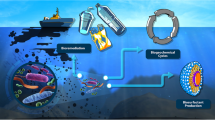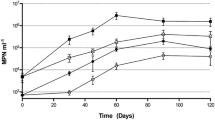Abstract
Microbes capable of using hydrocarbons as carbon and energy sources are widely distributed in marine environment and play a significant role in the mitigation of petroleum pollution. For the majority of marine microbes, their isolation and long-term maintenance in the laboratory is difficult. Among the hydrocarbon-degrading bacteria, there is a specific group of organisms, mainly within the class of Gammaproteobacteria, whose metabolism is restricted to the aliphatic and/or (poly)aromatic hydrocarbons and their derivatives. This group of marine obligately hydrocarbonoclastic bacteria consists of the several genera, namely, Alcanivorax, Cycloclasticus, Oleiphilus, Oleispira, Thalassolituus, and Oleibacter. This chapter discusses the methods for isolation, cultivation, and preservation of these hydrocarbonoclastic bacteria. Many different types of hydrocarbon-degrading bacteria have been isolated from a range of marine environments using minimal media amended with nutrients and hydrocarbons under various incubation conditions.
The original version of this chapter was revised. An erratum to the chapter can be found at DOI 10.1007/8623_2017_230
An erratum to this chapter can be found at http://dx.doi.org/10.1007/8623_2017_230
Access this chapter
Tax calculation will be finalised at checkout
Purchases are for personal use only
Similar content being viewed by others
References
Joint I, Mühling M, Querellou J (2010) Culturing marine bacteria- an essential prerequisite for biodiscovery. Microbiol Biotechnol 3:564–575. doi:10.1111/j.1751-7915.2010.00188.x
Yakimov MM, Timmis KN, Golyshin PN (2007) Obligate oil-degrading marine bacteria. Curr Opin Biotechnol 18:257–266. doi:10.1016/j.copbio.2007.04.006
Head IM, Jones DM, Röling WF (2006) Marine microorganisms make a meal of oil. Nat Rev Microbiol 4:173–182. doi:10.1038/nrmicro1348
Yakimov MM, Denaro R, Genovese M, Cappello S, D’Auria G, Chernikova TN et al (2005) Natural microbial diversity in superficial sediments of Milazzo Harbor (Sicily) and community successions during microcosm enrichment with various hydrocarbons. Environ Microbiol 7:1426–1441. doi:10.1111/j.1462-5822.2005.00829.x
Bragg JR, Prince RC, Harner EJ, Atlas RM (1994) Effectiveness of bioremediation for the Exxon Valdez oil spill. Nature 368:413–418. doi:10.1038/368413a0
McKew BA, Coulon F, Yakimov MM, Denaro R, Genovese M, Smith CJ et al (2007) Efficacy of intervention strategies for bioremediation of crude oil in marine systems and effects on indigenous hydrocarbonoclastic bacteria. Environ Microbiol 9:1562–1571. doi:10.1111/j.1462-2920.2007.01277.x
Cappello S, Denaro R, Genovese M, Giuliano L, Yakimov MM (2007) Predominant growth of Alcanivorax during experiments on “oil spill bioremediation” in mesocosms. Microbiol Res 162:185–190. doi:10.1016/j.micres.2006.05.010
Genovese M, Crisafi F, Denaro R, Cappello S, Russo D, Calogero R, Santisi S, Catalfamo M, Modica A, Smedile F, Genovese L, Golyshin PN, Giuliano L, Yakimov MM (2014) Effective bioremediation strategy for rapid in situ cleanup of anoxic marine sediments in mesocosm oil spill simulation. Front Microbiol 5:162. doi:10.3389/fmicb.2014.00162
Kimes NE, Callaghan AV, Suflita JM, Morris PJ (2014) Microbial transformation of the deepwater horizon oil spill—past, present, and future perspectives. Front Microbiol 5:603. doi:10.3389/fmicb.2014.00603
McGenity TJ, Folwell BD, McKew BA, Sanni GO (2012) Marine crude-oil biodegradation: a central role for interspecies interactions. Aquat Biosyst 8:10. doi:10.1186/2046-9063-8-10
Teramoto M, Queck SY, Ohnishi K (2013) Specialized hydrocarbonoclastic bacteria prevailing in seawater around a port in the Strait of Malacca. PLoS One 8(6):e66594. doi:10.1371/journal.pone.0066594
Hazen TC, Dubinsky EA, DeSantis TZ, Andersen GL, Piceno YM, Singh N et al (2010) Deep-sea oil plume enriches indigenous oil-degrading bacteria. Science 330:204–208. doi:10.1126/science.1195979
Yakimov MM, Golyshin PN, Lang S, Moore ERB, Abraham WR, Lünsdorf H et al (1998) Alcanivorax borkumensis gen. nov., sp. nov., a new, hydrocarbon-degrading and surfactant-producing marine bacterium. Int J Syst Bacteriol 48:339–348. doi:10.1099/00207713-48-2-339
Yakimov MM, Giuliano L, Denaro R, Crisafi E, Chernikova TN, Abraham WR et al (2004) Thalassolituus oleivorans gen. nov., sp. nov., a novel marine bacterium that obligately utilizes hydrocarbons. Int J Syst Evol Microbiol 54:141–148. doi:10.1099/ijs.0.02424-0
Golyshin PN, Chernikova TN, Abraham WR, Lünsdorf H, Timmis KN, Yakimov MM (2002) Oleiphilaceae fam. nov., to include Oleiphilus messinensis gen. nov., sp nov., a novel marine bacterium that obligately utilizes hydrocarbons. Int J Syst Evol Microbiol 52:901–911. doi:10.1099/ijs.0.01890-0
Yakimov MM, Giuliano L, Gentile G, Crisafi E, Chernikova TN, Abraham WR et al (2003) Oleispira antarctica gen. nov., sp. nov., a novel hydrocarbonoclastic marine bacterium isolated from Antarctic costal sea water. Int J Syst Evol Microbiol 53:779–785. doi:10.1099/ijs.0.02366-0
Dyksterhouse SE, Gray JP, Herwig RP, Lara JC, Staley JT (1995) Cycloclasticus pugetii gen. nov., sp. nov., an aromatic hydrocarbon-degrading bacterium from marine sediments. Int J Syst Bacteriol 45:116–123. doi:10.1099/00207713-45-1-116
Teramoto M, Ohuchi M, Hatmanti A, Darmayati Y, Widyastuti Y, Harayama S, Fukunaga Y (2011) Oleibacter marinus gen. nov., sp. nov., a bacterium that degrades petroleum aliphatic hydrocarbons in a tropical marine environment. Int J Syst Evol Microbiol 61:375–380. doi:10.1099/ijs.0.018671-0
Azevedo NF, Bragança SM, Simões LC, Cerqueira L, Almeida C, Keevil CW, Vieira MJ (2012) Proposal for a method to estimate nutrient shock effects in bacteria. BMC Res Notes 5:422. doi:10.1186/1756-0500-5-422
Pelz O, Tesar M, Wittich RM, Moore ERB, Timmis KN, Abraham WR (1999) Towards elucidation of microbial community metabolic pathways: unravelling the network of carbon sharing in a pollutant-degrading bacterial consortium by immunocapture and isotopic ratio mass spectrometry. Environ Microbiol 1:167–174. doi:10.1046/j.1462-2920.1999.00023.x
Kasai Y, Kishira H, Harayama S (2002) Bacteria belonging to the genus Cycloclasticus play a primary role in the degradation of aromatic hydrocarbons released in a marine environment. Appl Environ Microbiol 68:5625–5633. doi:10.1128/AEM.68.11.5625-5633.2002
Maruyama A, Ishiwata H, Kitamura K, Sunamura M, Fujita T, Matsuo M, Higashihara T (2003) Dynamics of microbial populations and strong selection for Cycloclasticus pugetii following the Nakhodka oil spill. Microb Ecol 46:442–453. doi:10.1007/s00248-002-3010-z
Cui Z, Xu G, Li Q, Gao W, Zheng L (2013) Genome sequence of the pyrene- and fluoranthene-degrading bacterium Cycloclasticus sp. strain PY97M. Genome Announc 1(4):e00536-13. doi:10.1128/genomeA.00536-13
Raggi L, Schubotz F, Hinrichs KU, Dubilier N, Petersen JM (2013) Bacterial symbionts of Bathymodiolus mussels and Escarpia tubeworms from Chapopote, an asphalt seep in the southern Gulf of Mexico. Environ Microbiol 15:1969–1987. doi:10.1111/1462-2920.12051
Arellano SM, Lee OO, Lafi FF, Yang J, Wang Y et al (2013) Deep sequencing of Myxilla (Ectyomyxilla) methanophila, an epibiotic sponge on cold-seep tubeworms, reveals methylotrophic, thiotrophic, and putative hydrocarbon-degrading microbial associations. Microb Ecol 65:450–461. doi:10.1007/s00248-012-0130-y
D’Onofrio A, Crawford JM, Stewart EJ, Witt K, Gavrish E, Epstein S, Clardy J, Lewis K (2010) Siderophores from neighboring organisms promote the growth of uncultured bacteria. Chem Biol 17:254–264. doi:10.1016/j.chembiol.2010.02.010
Denaro R, Crisafi F, Russo D, Genovese M, Messina E, Genovese L, Carbone M, Ciavatta ML, Ferrer M, Golyshin P, Yakimov MM (2014) Alcanivorax borkumensis produces an extracellular siderophore in iron-limitation condition maintaining the hydrocarbon-degradation efficiency. Mar Genomics 17:43–52. doi:10.1016/j.margen.2014.07.004
Staley JT (1968) Prosthecomicrobium and Ancalomicrobium: newfreshwater prosthecate bacteria. J Bacteriol 95:1921–1942
Shelton DR, Tiedje JM (1984) Isolation and partial characterization of bacteria in an anaerobic consortium that mineralizes 3-chlorobenzoic acid. Appl Environ Microbiol 48:840–848
Acknowledgments
This work was supported by the research fund from the European Commission’s Program under MicroB3 Project (Contract FP7-OCEAN.2011-2-287589). This work was supported by the research fund from the European Commission’s Program under the research project Kill*Spill “Integrated Biotechnological Solutions for Combating Marine Oil Spills” (FP7- KBBE-2012.3.5-01-4 Project 312139). BRAAVOO (FP7-KBBE OCEAN 2013.1 “Biosensors, Reporters and Algal Autonomous Vessels for Ocean Operation”)
Author information
Authors and Affiliations
Corresponding author
Editor information
Editors and Affiliations
Rights and permissions
Copyright information
© 2015 Springer-Verlag Berlin Heidelberg
About this protocol
Cite this protocol
Genovese, M. et al. (2015). Cultivation and Preservation of Hydrocarbonoclastic Microorganisms, Particularly Cycloclasticus Species. In: McGenity, T., Timmis, K., Nogales , B. (eds) Hydrocarbon and Lipid Microbiology Protocols. Springer Protocols Handbooks. Springer, Berlin, Heidelberg. https://doi.org/10.1007/8623_2015_167
Download citation
DOI: https://doi.org/10.1007/8623_2015_167
Published:
Publisher Name: Springer, Berlin, Heidelberg
Print ISBN: 978-3-662-45178-6
Online ISBN: 978-3-662-45179-3
eBook Packages: Springer Protocols




